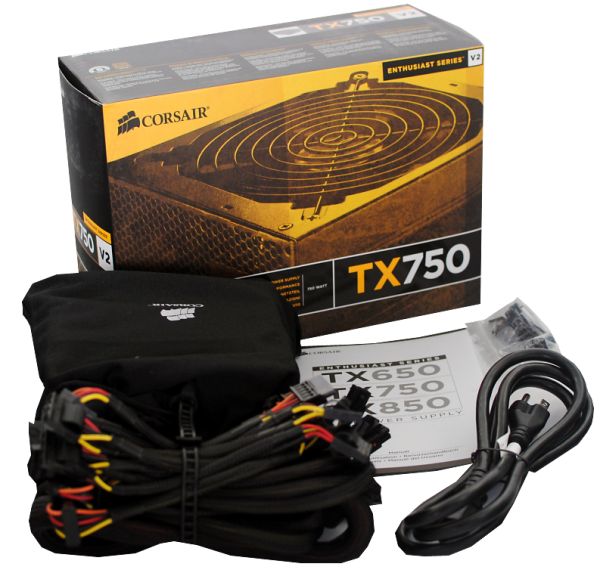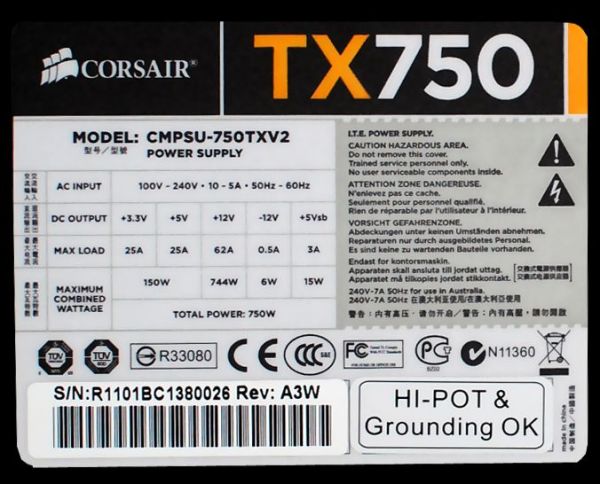Corsair TX750 V2: New and Improved
by Martin Kaffei on May 16, 2011 6:55 PM EST- Posted in
- Cases/Cooling/PSUs
- Corsair
- PSUs
- 80Plus Bronze
- 750W
- TX V2
Introduction, Package Contents, and Specifications
Today we continue with the second part of our series of 750W power supplies. The Corsair TX V2 is the second 80 Plus Bronze certified PSU with non-modular cables that we're looking at for this range. Corsair might be a leading manufacturer of RAM modules and SSDs, but power supply quality depends largely on the ODM and their design. The big question of the PSU source is easy to answer. Seasonic is the company behind many Corsair products—and they're definitely a good choice, much better than using CWT like the original TX750—but what about the internal design and components?
Corsair's TX V2 750W includes a power cord for the American power grid, four screws, one Corsair sticker (for your case), and a manual. The latter is more like a warranty agreement than a helping hand. There is an installation guide, but the warranty part shows some interesting limitations. "[Corsair] shall not be liable for any special, incidental, indirect or consequential damages [...] including [...] loss of profits, revenue, or data." So the 5-year warranty won't help you, other than getting a new PSU should the TX750 go belly up. Don't worry, though; these are common terms and are present with nearly every PSU.
While if it is not stated directly anywhere, the sticker indicates Corsair is using a single rail for +12V. We'll see later that this is not the case, so we'd like to see Corsair list both 12V rails on their sticker to avoid confusion. 744W combined power also indicates this is another PSU with DC-to-DC VRM. +3.3V and +5V are rated at 25A each and should be able to provide enough power for HDDs/SSDs and/or other peripheral components. 3A on +5VSB is also relatively strong.
Corsair uses a 140mm fan from Yate Loon with a ball bearing. The product number is D14BH-12 and it takes 0.70A. A Sanyo Denki fan would be better but the price could be a problem and Sanyo Denki is still a reason to buy the more expensive Corsair AX. Corsair differentiates between the two lines by modifications such as this, which helps them reach lower cost markets.













32 Comments
View All Comments
Patrick Wolf - Tuesday, May 17, 2011 - link
Agreed on power savings not being worth it. But if Platinum gives you a cooler running (less heat inside the case) and mostly silent (cause the fan stays off most of the time) power supply, then to some those are very compelling reasons to pay the premium.Makaveli - Tuesday, May 17, 2011 - link
Agree Patrick,This is the same reason I chose the 750AX over this model the fan being off at low load makes the system so quiet it was worth it.
erple2 - Tuesday, May 17, 2011 - link
I don't know if Platinum could give you all that much in the way of a cooler case - it would, however, give you a cooler power supply. Modern PSU design has air from the case passing through the PSU and out the back of the PC.it doesn't matter (at least not at the differences between Platinum through 80+) whether the PSU really gets any warmer to the temps in the rest of the case, as it's all downstream of the airflow in the case, unless you reverse the fan direction to blow air into the case.
MeanBruce - Friday, May 20, 2011 - link
I have heard the Platinum rating would be 92% efficiency at 50%load. Also heard that it would be 90% at 20, 50 and 80% loads, so not sure which standard was decided upon. I have the Corsair AX850 Gold and the fan never spins up during idle and running office apps, even if you put a game on the Sanyo Denki fan is so quiet it must be 10 or 12db in the silent mode. Above 50% load only then does the fan speed increase to an audible level. Another great feature of both the AX750 and AX850 is that the internal heat sinks are bonded to the exterior housing, allowing the metal psu chassis to also dissipate the heat produced and allowing the fan to remain off. And going a bit further, when I mounted the AX850 in my new Corsair 650D the metal rear and side panels surrounding the PSU become warm over extended use, so the 650D chassis also acts as a heat sink, Corsair is Brilliant!;)casteve - Tuesday, May 17, 2011 - link
Thanks for the review, Martin.What was the ambient SPL at the time of the test (and could you please include it with future PSU testing)? As is, we don't have a point of reference. The room could be 25dBA ambient and the PSU is lost in the background...the room could be an anechoic chamber with 11dBA ambient, making the PSU a vacuum cleaner.
Martin Kaffei - Tuesday, May 17, 2011 - link
Your request will be taken into account. I can't say how much dB, but we are starting from 16 dBA when a PSU is turned off. The dB(A) measurements are an instrument to show the difference to the competitors and of course to underline the subjective results. Latter one depends on the frequency, side noises (usually at a low frequency which is why db(A) is not always the best solution here) and the guy who is testing. :)When I write the PSU is "relatively loud" e.g. it's a subjective opionen that the PSU is audible for me. So you can be shure it's louder than other sources of noise in the room.
Lithium466 - Tuesday, May 17, 2011 - link
"Corsair uses a 140mm fan from Young Lin with a ball bearing. The product number is D14BH-12 and it takes 0.70A."=> Yate loon fan, not Young lin.
Martin Kaffei - Tuesday, May 17, 2011 - link
thanksmepenete - Tuesday, May 17, 2011 - link
I've had excellent luck with Corsair powersupplies, even the lower end budget ones. I was really surprised after only knowing Corsair for memory but they make good products. Glad to see they're staying up that high standardcelestialgrave - Wednesday, May 18, 2011 - link
What ever happened to measure the exhaust heat like a couple of years ago?